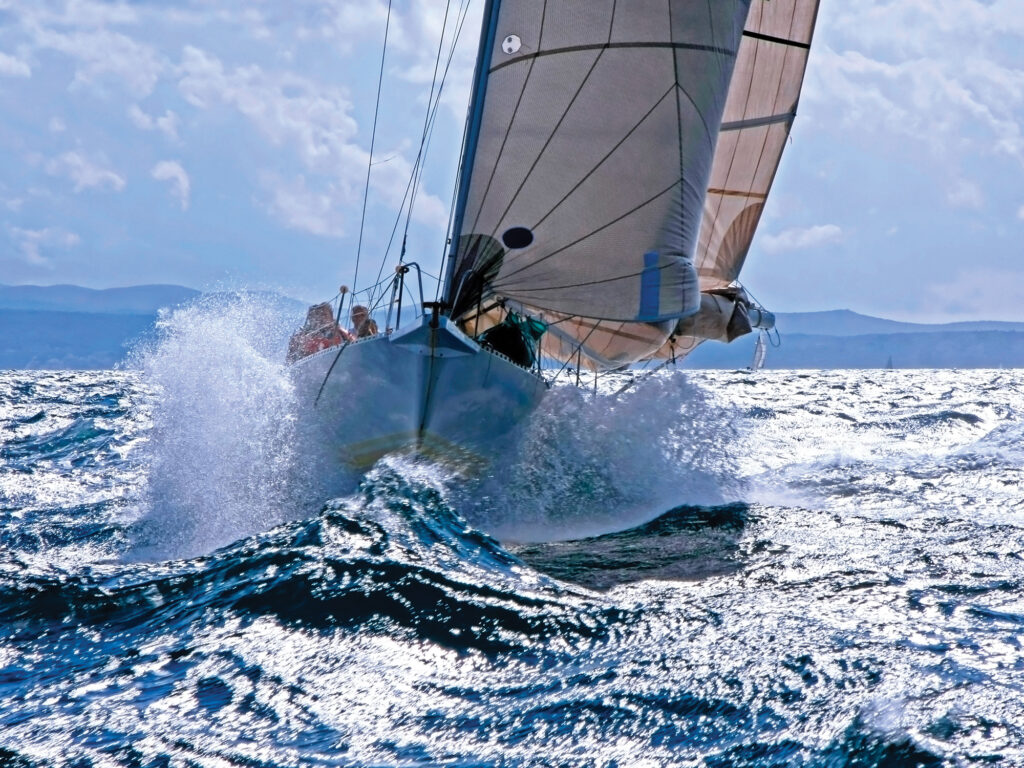
The Beach Boys had a great song with the lyrics: “Catch a wave, and you’re sitting on top of the world.” Of course, they were referring to a surfboard, but the line certainly fits for sailing.
Recently, I had a long sail to windward with a friend. We sailed south on the Chesapeake Bay starting early in the morning. A good thermal sea breeze filled in as the hours passed. About 20 miles south of Annapolis, Maryland, we stopped sailing for a lunch break before setting the asymmetrical spinnaker for the ride home. The beat to windward had taken five hours against a flooding tidal current. We were about to get our reward.
My Hood 32, Whirlwind, has a masthead asymmetrical spinnaker that sets out of the cockpit. Happily, I do not have to go on the foredeck. A tack line under the deck extends back to the cockpit, and all the lines can be trimmed from one spot.
The wind was blowing a steady 16 to 18 knots, and the waves were 2 to 3 feet. Whirlwind displaces 2,800 pounds and flies downwind at 8 to 10 knots. My crewmember, Brian, was relatively new to steering with an asymmetrical sail. He was at the helm as I set the sail up for hoisting. Usually, I am comfortable in the after part of the boats that I race or cruise. On Whirlwind, I get to handle the spinnaker.
We set the spinnaker and trimmed in for the ride. The boat took off. I was now the sail trimmer and coach. As we accelerated down our first wave, a determined smile appeared on Brian’s face.
My first comment was that good helmsmanship is moving the tiller as little as possible. The faster you turn, the more the boat will slow down, and a fast turn can cause the sail to collapse. I advised him to keep his arm at a 90-degree angle to the tiller. The direct motion on the tiller minimizes oversteering.
The next goal was to catch the wave. To do this, you have to watch the wave ahead of the bow. Look for deep troughs. Aim the bow toward the lowest part of the trough, and then work to accelerate. You can gain speed by giving the spinnaker and mainsail a rapid trim and by altering course to more of a reach. When the boat gains speed, you can alter your course to follow the wave.
Don’t overtrim the spinnaker. Doing so can cause the boat to spin out of control. However, it is easy to forget to trim the mainsail. When we bore off to set the spinnaker, I eased out the outhaul and let off the downhaul to give the mainsail more shape.
Getting the correct tension on the boom vang is important. If the vang is too tight, then the boat can get out of control. As a rule, I look up at the top batten in the mainsail and try to adjust the boom vang so that the top batten is parallel to the boom. When in doubt, it is better to leave the boom vang a little eased than to sail with it too tight.
The waves on this day seemed to be a little higher in the middle of the Chesapeake, where the water is deeper. By late afternoon, the tidal current had shifted, and we were bucking the tide again, but the opposing forces of the wind against the current created higher waves. So there was a silver lining.
When you get everything just right, the boat slides down the wave and you pick up speed. Steering is easy as the apparent wind moves aft, taking the pressure off the sails. Our game that afternoon was to see how long we could maintain the ride on each wave.
A few times, we were able to skip from one wave to another. An asymmetrical spinnaker is a nice sail that provides plenty of flexibility while steering a course. In strong gusts, we simply sailed a lower course. In light patches, we headed up and sailed a higher course to keep the boat moving.
I noted that no other boats were passing us. Our upwind five-hour sail was fun, but the 20-mile run home was better; we averaged 8 knots and arrived back in two and a half hours. Even when daysailing, my competitive instinct kicks in. I like sailing fast and being comfortable. Riding waves achieves both goals.








